Kidney (renal cell) Cancer
- Renal cell cancer is a type of cancer that forms in tubules of the kidney.
- Smoking and misuse of certain pain medicines can affect the risk of renal cell cancer.
- Signs of renal cell cancer include blood in the urine and a lump in the abdomen.
- Tests that examine the abdomen and kidneys are used to diagnose renal cell cancer.
- After renal cell cancer has been diagnosed, tests are done to find out if cancer cells have spread within the kidney or to other parts of the body.
- Certain factors affect prognosis (chance of recovery) and treatment options.
Renal cell cancer (also called renal cell adenocarcinoma) is a disease in which cancer cells are found in the lining of tubules (very small tubes) in the kidney. It is the most common type of kidney cancer in adults. There are two kidneys, one on each side of the backbone, above the waist. Tiny tubules in the kidneys filter and clean the blood. They take out waste products and make urine. The urine passes from each kidney through a long tube called a ureter into the bladder. The bladder holds the urine until it passes through the urethra and leaves the body.
Enlarge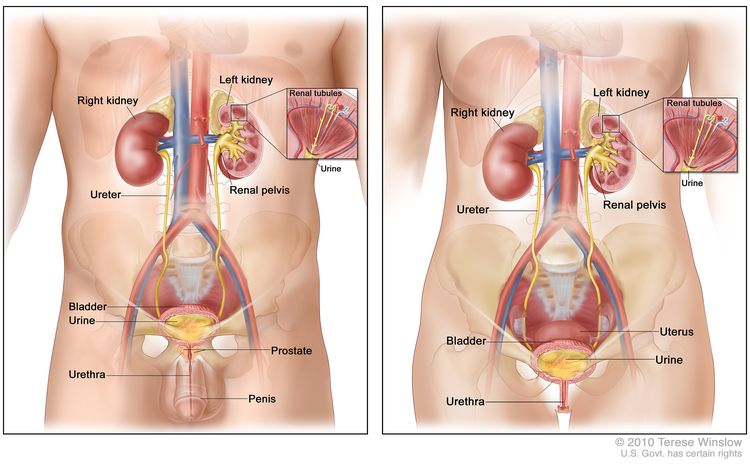 Anatomy of the male urinary system (left panel) and female urinary system (right panel) showing the kidneys, ureters, bladder, and urethra. The inside of the left kidney shows the renal pelvis. An inset shows the renal tubules and urine. Also shown are the prostate and penis (left panel) and the uterus (right panel). Urine is made in the renal tubules and collects in the renal pelvis of each kidney. The urine flows from the kidneys through the ureters to the bladder. The urine is stored in the bladder until it leaves the body through the urethra.
Anatomy of the male urinary system (left panel) and female urinary system (right panel) showing the kidneys, ureters, bladder, and urethra. The inside of the left kidney shows the renal pelvis. An inset shows the renal tubules and urine. Also shown are the prostate and penis (left panel) and the uterus (right panel). Urine is made in the renal tubules and collects in the renal pelvis of each kidney. The urine flows from the kidneys through the ureters to the bladder. The urine is stored in the bladder until it leaves the body through the urethra.Cancer that starts in the ureters or the renal pelvis (the part of the kidney that collects urine and drains it to the ureters) is different from renal cell cancer. For more information, visit Transitional Cell Cancer of the Renal Pelvis and Ureter Treatment.
Smoking and misuse of certain pain medicines can affect the risk of renal cell cancer.Renal cell cancer is caused by certain changes to the way renal cells function, especially how they grow and divide into new cells. There are many risk factors for renal cell cancer, but many do not directly cause cancer. Instead, they increase the chance of DNA damage in cells that may lead to renal cell cancer. Learn more about how cancer develops at What Is Cancer?
A risk factor is anything that increases the chance of getting a disease. Some risk factors for renal cell cancer, like smoking, can be changed. However, risk factors also include things you cannot change, like your genetics, getting older, and your family history. Learning about risk factors for renal cell cancer can help you make changes that might lower your risk of getting it.
Risk factors for renal cell cancer include:
- smoking tobacco
- misusing certain pain medicines, including over-the-counter pain medicines, for a long time
- having excess body weight
- having high blood pressure
- having a family history of renal cell cancer
- having certain genetic conditions, such as von Hippel-Lindau disease or hereditary papillary renal cancer
Tobacco use is a leading cause of cancer and death from cancer. Learn more about Tobacco (includes help with quitting).
Having one or more of these risk factors does not mean you will get renal cell cancer. Many people with risk factors never develop renal cell cancer, while others with no known risk factors do. Talk with your doctor if you think you may be at risk.
Signs of renal cell cancer include blood in the urine and a lump in the abdomen.These and other signs and symptoms may be caused by renal cell cancer or by other conditions. There may be no signs or symptoms in the early stages. Signs and symptoms may appear as the tumor grows. Check with your doctor if you have:
In addition to asking about your personal and family health history and doing a physical exam, your doctor may perform the following tests and procedures:
- Ultrasound exam uses high-energy sound waves (ultrasound) that bounce off internal tissues or organs and make echoes. The echoes form a picture of body tissues called a sonogram.
- Blood chemistry study uses a blood sample to measure the amounts of certain substances released into the blood by organs and tissues in the body. An unusual (higher or lower than normal) amount of a substance can be a sign of disease.
- Urinalysis checks the color of urine and its contents, such as sugar, protein, red blood cells, and white blood cells.
- CT scan (CAT scan) uses a computer linked to an x-ray machine to make a series of detailed pictures of areas inside the body, such as the abdomen and pelvis. The pictures are taken from different angles and are used to create 3-D views of tissues and organs. A dye may be injected into a vein or swallowed to help the organs or tissues show up more clearly. This procedure is also called computed tomography, computerized tomography, or computerized axial tomography.
- MRI (magnetic resonance imaging) uses a magnet, radio waves, and a computer to make a series of detailed pictures of areas inside the body. This procedure is also called nuclear magnetic resonance imaging (NMRI).
- Biopsy is the removal of cells or tissues so they can be viewed under a microscope by a pathologist to check for signs of cancer. To do a biopsy for renal cell cancer, a thin needle is inserted into the tumor and a sample of tissue is withdrawn. A biopsy may not be needed if the imaging test results provide enough information to make a diagnosis.
The process used to find out if cancer has spread within the kidney or to other parts of the body is called staging. The information gathered from the staging process determines the stage of the disease. It is important to know the stage in order to plan treatment.
Some of the tests and procedures used to diagnose liver cancer, such as CT scan and MRI, may be used in the staging process. Other tests include:
- Chest x-ray is a type of radiation that can go through the body and make pictures of organs and bones inside the chest.
- Bone scan is a procedure to check if there are rapidly dividing cells, such as cancer cells, in the bone. A very small amount of radioactive material is injected into a vein and travels through the bloodstream. The radioactive material collects in the bones with cancer and is detected by a scanner.
You may want to get a second opinion to confirm your renal cell cancer diagnosis and treatment plan. If you seek a second opinion, you will need to get medical test results and reports from the first doctor to share with the second doctor. The second doctor will review the pathology report, slides, and scans. They may agree with the first doctor, suggest changes or another treatment approach, or provide more information about your cancer.
To learn more about choosing a doctor and getting a second opinion, see Finding Cancer Care. You can contact NCI's Cancer Information Service via chat, email, or phone (both in English and Spanish) for help finding a doctor, hospital, or getting a second opinion. For questions you might want to ask at your appointments, see Questions to Ask Your Doctor About Cancer.
Certain factors affect prognosis (chance of recovery) and treatment options.The prognosis and treatment options depend on:
- the stage of the disease
- your age and general health
- The following stages are used for renal cell cancer:
- Stage I (also called stage 1) renal cell cancer
- Stage II (also called stage 2) renal cell cancer
- Stage III (also called stage 3) renal cell cancer
- Stage IV (also called stage 4) renal cell cancer
- Renal cell cancer can recur (come back) many years after initial treatment.
Cancer stage describes the extent of cancer in the body, such as the size of the tumor, whether it has spread, and how far it has spread from where it first formed.
There are several staging systems for cancer that describe the extent of the cancer. Renal cell cancer staging usually uses the TNM staging system. The cancer may be described by this staging system in your pathology report. Based on the TNM results, a stage (I, II, III, or IV, also written as 1, 2, 3, or 4) is assigned to your cancer. When talking to you about your diagnosis, your doctor may describe the cancer as one of these stages.
Learn about tests to stage renal cell cancer. Learn more about Cancer Staging.
The following stages are used for renal cell cancer:Stage I (also called stage 1) renal cell cancerEnlarge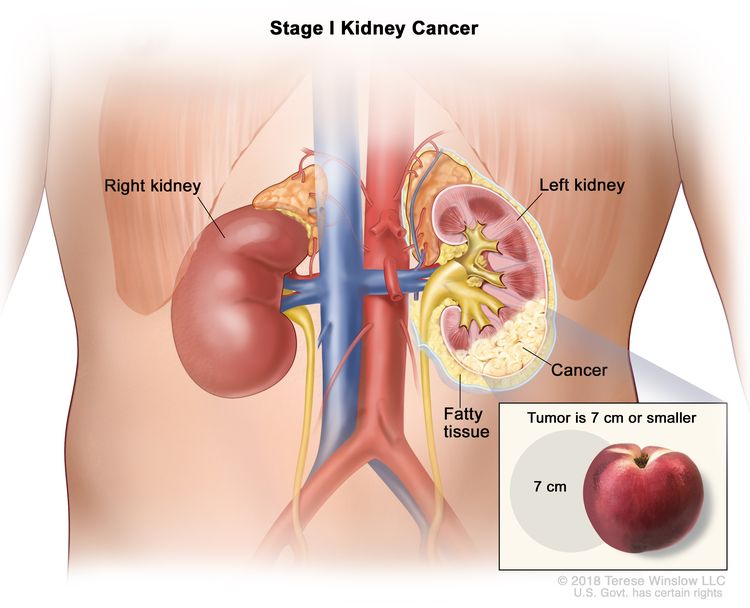 Stage I kidney cancer. The tumor is 7 centimeters or smaller and is found in the kidney only.
Stage I kidney cancer. The tumor is 7 centimeters or smaller and is found in the kidney only.In stage I, the tumor is 7 centimeters or smaller and is found in the kidney only.
Stage II (also called stage 2) renal cell cancerEnlarge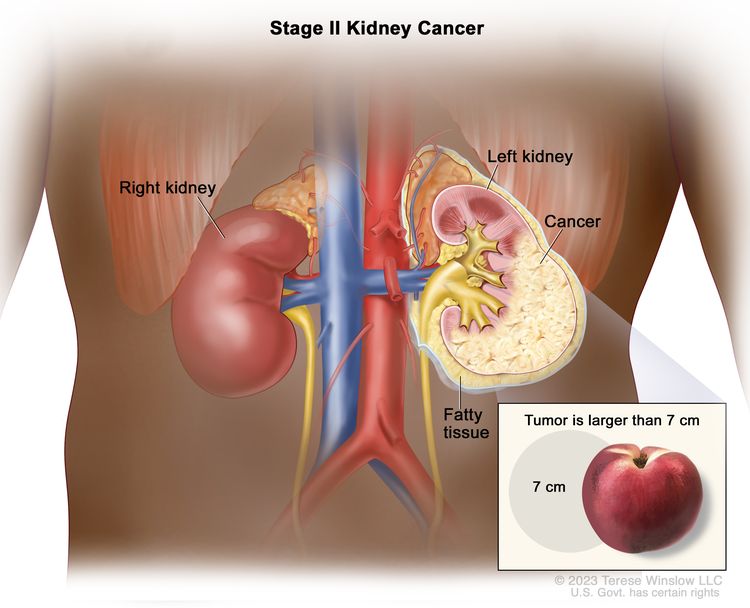 Stage II kidney cancer. The tumor is larger than 7 centimeters and is found in the kidney only.
Stage II kidney cancer. The tumor is larger than 7 centimeters and is found in the kidney only.In stage II, the tumor is larger than 7 centimeters and is found in the kidney only.
Stage III (also called stage 3) renal cell cancerEnlarge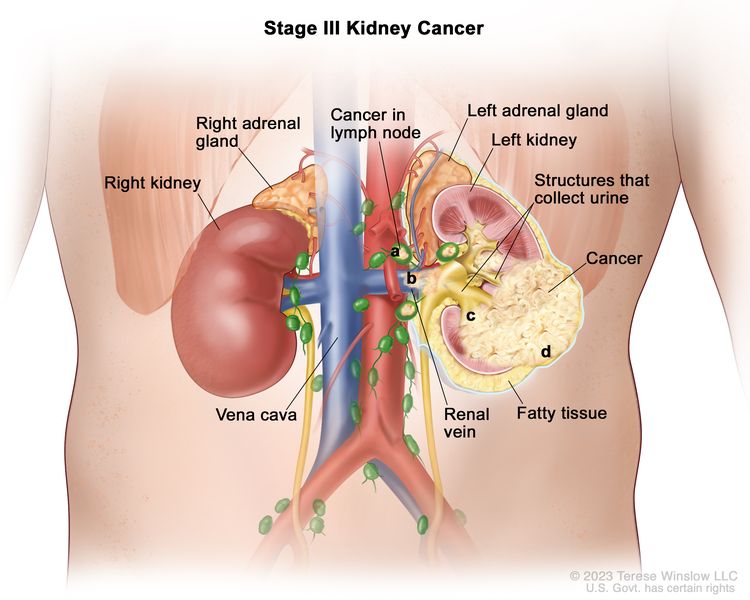 Stage III kidney cancer. The cancer in the kidney is any size and cancer has spread to a) nearby lymph nodes, b) the blood vessels in or near the kidney (renal vein or vena cava), c) the structures in the kidney that collect urine, or d) the layer of fatty tissue around the kidney.
Stage III kidney cancer. The cancer in the kidney is any size and cancer has spread to a) nearby lymph nodes, b) the blood vessels in or near the kidney (renal vein or vena cava), c) the structures in the kidney that collect urine, or d) the layer of fatty tissue around the kidney.In stage III, one of the following is found:
- the cancer in the kidney is any size, and cancer has spread to nearby lymph nodes; or
- cancer has spread to blood vessels in or near the kidney (renal vein or vena cava), to the fat around the structures in the kidney that collect urine, or to the layer of fatty tissue around the kidney and may have spread to nearby lymph nodes.
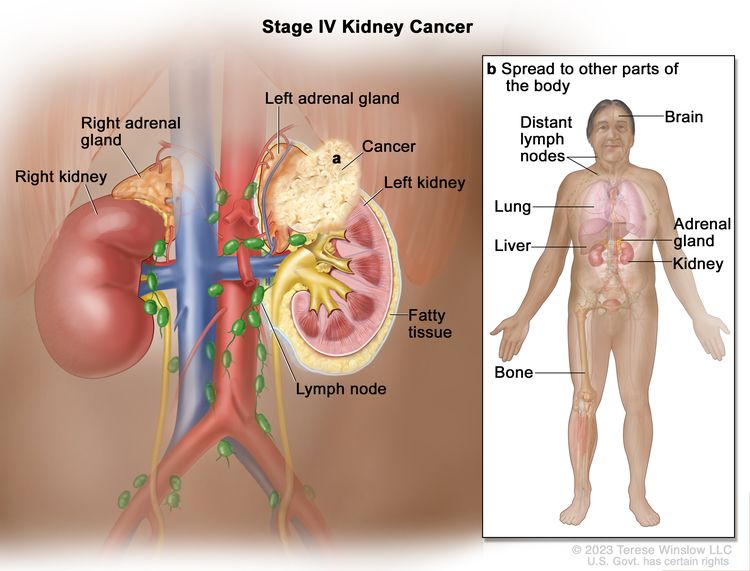 Stage IV kidney cancer. Cancer has spread a) beyond the layer of fatty tissue around the kidney and may have spread into the adrenal gland above the kidney with cancer or to nearby lymph nodes, or b) to other parts of the body, such as the brain, lung, liver, adrenal gland, bone, or distant lymph nodes.
Stage IV kidney cancer. Cancer has spread a) beyond the layer of fatty tissue around the kidney and may have spread into the adrenal gland above the kidney with cancer or to nearby lymph nodes, or b) to other parts of the body, such as the brain, lung, liver, adrenal gland, bone, or distant lymph nodes.In stage IV, one of the following is found:
- cancer has spread beyond the layer of fatty tissue around the kidney and may have spread into the adrenal gland above the kidney with cancer or to nearby lymph nodes; or
- cancer has spread to other parts of the body, such as the bones, liver, lungs, brain, adrenal glands, or distant lymph nodes.
Stage IV renal cell cancer is also called metastatic renal cell cancer. Metastatic cancer happens when cancer cells travel through the lymphatic system or blood and form tumors in other parts of the body. The metastatic tumor is the same type of cancer as the primary tumor. For example, if renal cell cancer spreads to the liver, the cancer cells in the liver are actually renal cell cancer. The disease is called metastatic renal cell cancer, not liver cancer. Learn more in Metastatic Cancer: When Cancer Spreads.
Renal cell cancer can recur (come back) many years after initial treatment.Recurrent renal cell cancer is cancer that has come back after it has been treated. If renal cell cancer comes back, it may come back in the kidney or in other parts of the body. Tests will be done to help determine where the cancer has returned. The type of treatment for recurrent renal cell cancer will depend on where it has come back.
Learn more in Recurrent Cancer: When Cancer Comes Back.
- There are different types of treatment for people with renal cell cancer.
- The following types of treatment are used:
- Surgery
- Radiation therapy
- Immunotherapy
- Targeted therapy
- New types of treatment are being tested in clinical trials.
- Treatment for renal cell cancer may cause side effects.
- Follow-up care may be needed.
Different types of treatments are available for people with renal cell cancer. You and your cancer care team will work together to decide your treatment plan, which may include more than one type of treatment. Many factors will be considered, such as the stage of the cancer, your overall health, and your preferences. Your plan will include information about your cancer, the goals of treatment, your treatment options and the possible side effects, and the expected length of treatment.
Talking with your cancer care team before treatment begins about what to expect will be helpful. You'll want to learn what you need to do before treatment begins, how you'll feel while going through it, and what kind of help you will need. To learn more, see Questions to Ask Your Doctor About Treatment.
The following types of treatment are used:SurgerySurgery to remove part or all of the kidney is often used to treat renal cell cancer. The following types of surgery may be used:
- Partial nephrectomy is surgery to remove the cancer within the kidney and some of the tissue around it. A partial nephrectomy may be done to prevent loss of kidney function when the other kidney is damaged or has already been removed.
- Simple nephrectomy is surgery to remove the kidney only.
- Radical nephrectomy is surgery to remove the kidney, the adrenal gland, surrounding tissue, and usually nearby lymph nodes.
A person can live with part of one working kidney, but if both kidneys are removed or not working, the person will need dialysis (a procedure to clean the blood using a machine outside of the body) or a kidney transplant (replacement with a healthy donated kidney). A kidney transplant may be done when the disease is in the kidney only and a donated kidney can be found. If the person has to wait for a donated kidney, other treatment is given as needed.
After the doctor removes all the cancer that can be seen at the time of the surgery, some people may receive radiation therapy to kill any cancer cells that are left. Treatment given after surgery to lower the risk that the cancer will come back is called adjuvant therapy.
When surgery to remove the cancer is not possible, other procedures might be done:
- Arterial embolization may be used to shrink the tumor. A small incision (cut) is made, and a catheter (thin tube) is inserted into the main blood vessel that flows to the kidney. Small pieces of a special gelatin sponge are injected through the catheter into the blood vessel. The sponges block the blood flow to the kidney and prevent the cancer cells from getting oxygen and other substances they need to grow.
- Cryosurgery uses an instrument to freeze and destroy abnormal tissue. This type of treatment is also called cryotherapy. Learn more about Cryosurgery to Treat Cancer.
- Thermal ablation (also called hyperthermia) uses heat to destroy abnormal tissue. Learn more about Hyperthermia to Treat Cancer.
Radiation therapy uses high-energy x-rays or other types of radiation to kill cancer cells or keep them from growing. External beam radiation therapy uses a machine outside the body to send radiation toward the area of the body with cancer. External beam radiation therapy is used to treat renal cell cancer, and may also be used as palliative therapy to relieve symptoms and improve quality of life. A specific way to give radiation therapy called stereotactic ablative body radiation therapy, or stereotactic radiosurgery, may be used in some cases.
Learn more about External Beam Radiation Therapy for Cancer and Radiation Therapy Side Effects.
ImmunotherapyImmunotherapy helps a person's immune system fight cancer. Your doctor may suggest biomarker tests to help predict your response to certain immunotherapy drugs. Learn more about Biomarker Testing for Cancer Treatment.
Immunotherapy drugs used to treat renal cell cancer include:
Learn more about Immunotherapy to Treat Cancer.
Targeted therapyTargeted therapy uses drugs or other substances to identify and attack specific cancer cells. Your doctor may suggest biomarker tests to help predict your response to certain targeted therapy drugs. Learn more about Biomarker Testing for Cancer Treatment.
Targeted therapies used to treat renal cell cancer include:
Learn more about Targeted Therapy to Treat Cancer.
New types of treatment are being tested in clinical trials.For some people, joining a clinical trial may be an option. There are different types of clinical trials for people with cancer. For example, a treatment trial tests new treatments or new ways of using current treatments. Supportive care and palliative care trials look at ways to improve quality of life, especially for those who have side effects from cancer and its treatment.
You can use the clinical trial search to find NCI-supported cancer clinical trials accepting participants. The search allows you to filter trials based on the type of cancer, your age, and where the trials are being done. Clinical trials supported by other organizations can be found on the ClinicalTrials.gov website.
Learn more about clinical trials, including how to find and join one, at Clinical Trials Information for Patients and Caregivers.
Treatment for renal cell cancer may cause side effects.For information about side effects caused by treatment for cancer, visit our Side Effects page.
Follow-up care may be needed.As you go through treatment, you will have follow-up tests or check-ups. Some tests that were done to diagnose or stage the cancer may be repeated to see how well the treatment is working. Decisions about whether to continue, change, or stop treatment may be based on the results of these tests.
Some of the tests will continue to be done from time to time after treatment has ended. The results of these tests can show if your condition has changed or if the cancer has recurred (come back).
After treatment for renal cell cancer, a blood test to measure amounts of carcinoembryonic antigen (a substance in the blood that may be increased when cancer is present) may be done to see if the cancer has come back.
The main treatment for stage I renal cell cancer is surgery:
If surgery isn't an option, treatment options may include:
- cryotherapy
- thermal ablation
- stereotactic ablative body radiation therapy (a type of external beam radiation therapy)
If none of these treatments is an option, palliative therapy aimed at relieving symptoms may include:
Learn more about these treatments in the Treatment Option Overview.
Use our clinical trial search to find NCI-supported cancer clinical trials that are accepting patients. You can search for trials based on the type of cancer, the age of the patient, and where the trials are being done. General information about clinical trials is also available.
Treatment of stage II renal cell cancer may include:
- partial nephrectomy
- radical nephrectomy
- radical nephrectomy followed by pembrolizumab, for cancer that is at high risk of coming back
- nephrectomy before or after external beam radiation therapy
- external beam radiation therapy or arterial embolization as palliative therapy to relieve symptoms, if surgery isn't an option
Learn more about these treatments in the Treatment Option Overview.
Use our clinical trial search to find NCI-supported cancer clinical trials that are accepting patients. You can search for trials based on the type of cancer, the age of the patient, and where the trials are being done. General information about clinical trials is also available.
Treatment of stage III renal cell cancer may include:
- radical nephrectomy
- arterial embolization to reduce blood loss during surgery followed by radical nephrectomy
- radical nephrectomy followed by pembrolizumab or sunitinib
- external beam radiation therapy or arterial embolization as palliative therapy to relieve symptoms and improve the quality of life
- external beam radiation therapy before or after surgery (radical nephrectomy), for certain people with more extensive tumors
Learn more about these treatments in the Treatment Option Overview.
Use our clinical trial search to find NCI-supported cancer clinical trials that are accepting patients. You can search for trials based on the type of cancer, the age of the patient, and where the trials are being done. General information about clinical trials is also available.
First-line treatment of stage IV renal cell cancer may include:
- ipilimumab plus nivolumab
- pembrolizumab plus axitinib
- pembrolizumab plus lenvatinib
- nivolumab plus cabozantinib
- radical nephrectomy
- nephrectomy to reduce the size of the tumor in people with certain favorable tumor types
- cabozanitnib
- avelumab plus axitinib
- sunitinib
- pazopanib
- sorafenib
- temsirolimus
- bevacizumab with or without interferon
- interferon
- interleukin-2
- palliative radiation therapy
Second-line treatment may include:
- nivolumab (for people previously treated with sunitinib, pazopanib, sorafenib, and/or axitinib)
- lenvatinib plus everolimus (for people previously treated with sunitinib, pazopanib, cabozantinib, axitinib, or sorafenib)
- cabozantinib (for people previously treated with sunitinib, pazopanib, sorafenib, or axitinib)
- axitinib
- everolimus (for people previously treated with sunitinib and/or sorafenib)
- sorafenib
- palliative radiation therapy
Third-line and fourth-line treatment may include:
Learn more about these treatments in the Treatment Option Overview.
Use our clinical trial search to find NCI-supported cancer clinical trials that are accepting patients. You can search for trials based on the type of cancer, the age of the patient, and where the trials are being done. General information about clinical trials is also available.
For more information from the National Cancer Institute about renal cell cancer, visit:
For general cancer information and other resources from the National Cancer Institute, visit:
Physician Data Query (PDQ) is the National Cancer Institute's (NCI's) comprehensive cancer information database. The PDQ database contains summaries of the latest published information on cancer prevention, detection, genetics, treatment, supportive care, and complementary and alternative medicine. Most summaries come in two versions. The health professional versions have detailed information written in technical language. The patient versions are written in easy-to-understand, nontechnical language. Both versions have cancer information that is accurate and up to date and most versions are also available in Spanish.
PDQ is a service of the NCI. The NCI is part of the National Institutes of Health (NIH). NIH is the federal government’s center of biomedical research. The PDQ summaries are based on an independent review of the medical literature. They are not policy statements of the NCI or the NIH.
Purpose of This SummaryThis PDQ cancer information summary has current information about the treatment of renal cancer. It is meant to inform and help patients, families, and caregivers. It does not give formal guidelines or recommendations for making decisions about health care.
Reviewers and UpdatesEditorial Boards write the PDQ cancer information summaries and keep them up to date. These Boards are made up of experts in cancer treatment and other specialties related to cancer. The summaries are reviewed regularly and changes are made when there is new information. The date on each summary ("Updated") is the date of the most recent change.
The information in this patient summary was taken from the health professional version, which is reviewed regularly and updated as needed, by the PDQ Adult Treatment Editorial Board.
Clinical Trial InformationA clinical trial is a study to answer a scientific question, such as whether one treatment is better than another. Trials are based on past studies and what has been learned in the laboratory. Each trial answers certain scientific questions in order to find new and better ways to help cancer patients. During treatment clinical trials, information is collected about the effects of a new treatment and how well it works. If a clinical trial shows that a new treatment is better than one currently being used, the new treatment may become "standard." Patients may want to think about taking part in a clinical trial. Some clinical trials are open only to patients who have not started treatment.
Clinical trials can be found online at NCI's website. For more information, call the Cancer Information Service (CIS), NCI's contact center, at 1-800-4-CANCER (1-800-422-6237).
Permission to Use This SummaryPDQ is a registered trademark. The content of PDQ documents can be used freely as text. It cannot be identified as an NCI PDQ cancer information summary unless the whole summary is shown and it is updated regularly. However, a user would be allowed to write a sentence such as “NCI’s PDQ cancer information summary about breast cancer prevention states the risks in the following way: [include excerpt from the summary].”
The best way to cite this PDQ summary is:
PDQ® Adult Treatment Editorial Board. PDQ Renal Cell Cancer Treatment. Bethesda, MD: National Cancer Institute. Updated <MM/DD/YYYY>. Available at: https://www.cancer.gov/types/kidney/patient/kidney-treatment-pdq. Accessed <MM/DD/YYYY>. [PMID: 26389448]
Images in this summary are used with permission of the author(s), artist, and/or publisher for use in the PDQ summaries only. If you want to use an image from a PDQ summary and you are not using the whole summary, you must get permission from the owner. It cannot be given by the National Cancer Institute. Information about using the images in this summary, along with many other images related to cancer can be found in Visuals Online. Visuals Online is a collection of more than 3,000 scientific images.
DisclaimerThe information in these summaries should not be used to make decisions about insurance reimbursement. More information on insurance coverage is available on Cancer.gov on the Managing Cancer Care page.
Contact UsMore information about contacting us or receiving help with the Cancer.gov website can be found on our Contact Us for Help page. Questions can also be submitted to Cancer.gov through the website’s E-mail Us.
Updated: May 12, 2025
The content on this page is originally published by the National Cancer Institute.
Click here to see the original content on their site.
